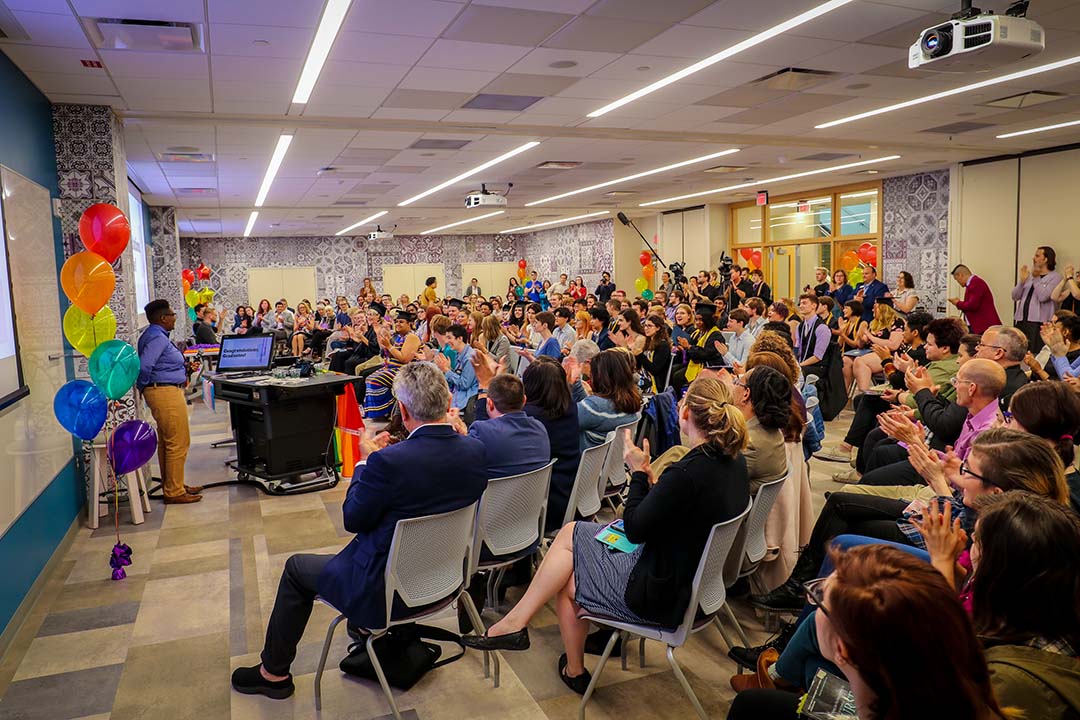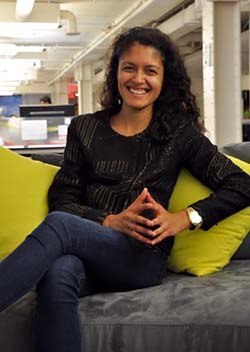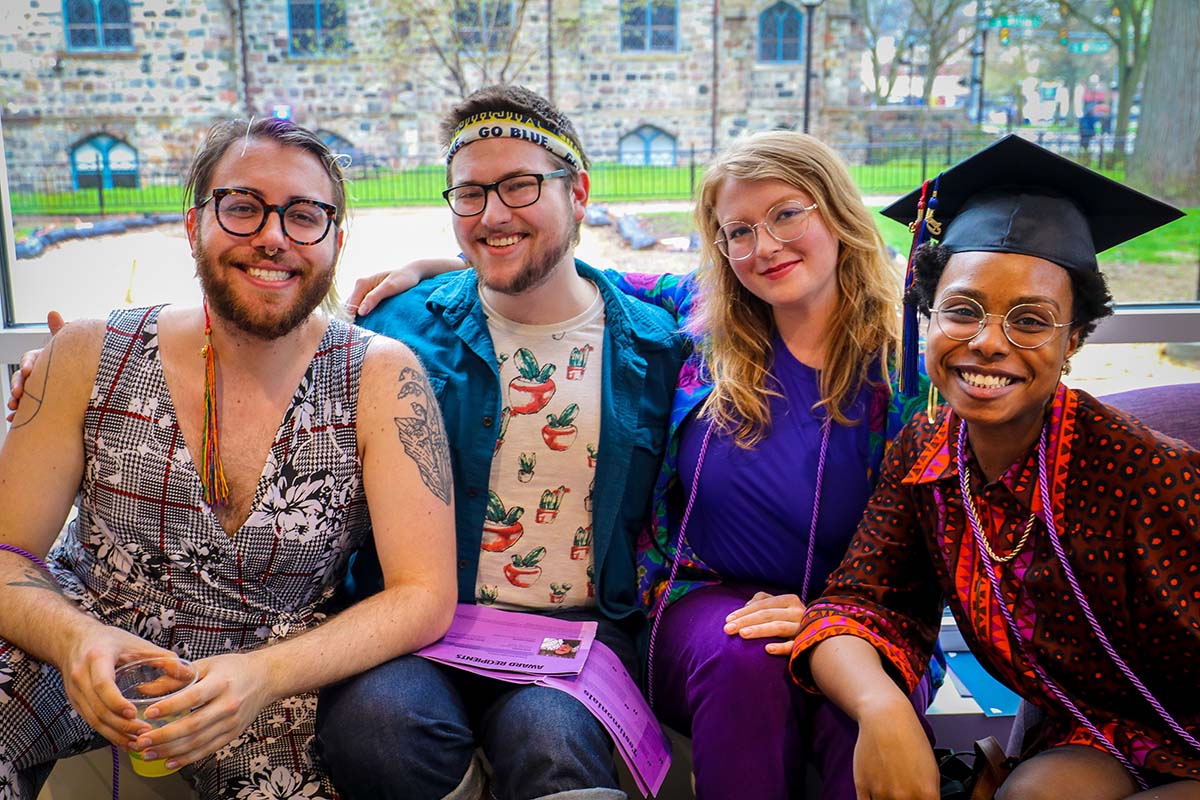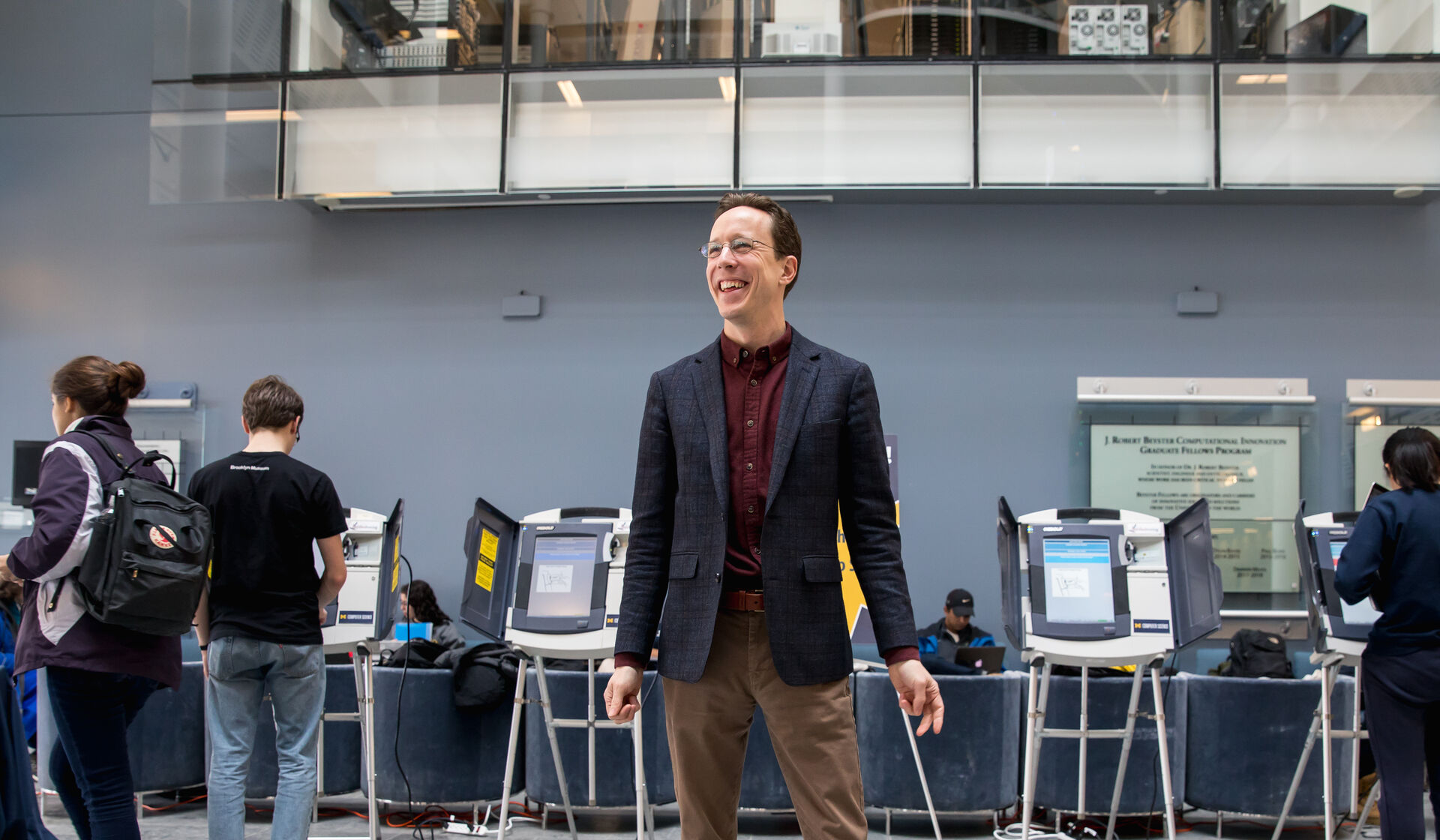The Spectrum Center at 50
•
STREET PHOTO COURTESY OF THE BENTLEY HISTORICAL LIBRARY | JUDITH LEVY PHOTO COURTESY OF JUDITH LEVY | ADITI HARDIKAR PHOTO COURTESY OF ADITI HARDIKAR | LAVGRAD PHOTOS COURTESY OF THE SPECTRUM CENTER
When it launched in September 1971, U-M’s Human Sexuality Office was the first LGBTQ+ group on any campus in the U.S. to have paid staffers—founders Jim Toy, MSW’81, and Cindy Gair. (For more about Toy, see “Climbing the Mountain of Justice.”) The organization offered counseling services and other support to gay and lesbian students and grew into a modern, established student group over decades. In 2008, it took on its current moniker, Spectrum Center, to include the gamut of sexual and gender identities that makes up its mission.
This academic year, the center is celebrating its 50th anniversary. To honor this milestone, Michigan Alum held a lively Zoom interview with two prominent LGBTQ+ alumnae of different eras, U.S. District Judge Judith Levy, ’81, JD’96, and Aditi Hardikar, ’11, deputy chief of staff at the U.S. Treasury based in Chicago.
After leaving U-M, each assumed important roles in the movement. Levy, who in 2014 became the first openly gay or lesbian federal judge in Michigan, also served as a clerk to U.S. District Judge Bernard Friedman. A Reagan appointee, Friedman struck down Michigan’s same-sex marriage ban in 2014 and has credited his long friendship with Levy with helping him understand the importance of legal protections for all families. Hardikar served as LGBT outreach liaison for the Obama administration between 2014 and 2016, which includes the June 2015 decision by the U.S. Supreme Court to make marriage equality the law of the land.
Both credit the existence of the Spectrum Center, however it was known in their day, with helping them to come out, accept themselves, and flourish as Wolverines on and off campus. Until now, however, they’d never met. Here’s the conversation, which has been edited for clarity and space.

Let’s start with Judy. Where were you in your journey when you arrived on campus?
LEVY: I was a transfer student here. I started college in 1976 at Oberlin College and came out there. A group of four or five of us formed the Oberlin Gay Union. Ultimately, it was too small a college for me. I wasn’t focused enough academically. I was really focused on trying to come out. That was my sole purpose and mission in life at that time. I was searching around for a bigger environment. I had heard—with no internet!—that there were gay people in Ann Arbor. So I showed up here in 1978 and said, “I’m going to find the gay people.” I found the Woman’s Space Bookstore on Fourth Avenue, where the Birkenstock store is now. That was really scary, going in there. They’re going to know I’m a lesbian as soon as I set foot in here. I mean, it’s what I wanted, but still.

You did that before finding the gay group at U-M?
LEVY: Yeah. That was the second thing. I went looking for this gay office that I had heard about. It was a ti
ny little space in the Michigan Union. I just walked by, didn’t go in, walked by, and sooner or later, went in. It was very encouraging and exciting.
Why was it so easy for you to accept yourself?
LEVY: I often wonder that. I just got born lucky. I didn’t have a sense of fear. I came out to my parents in 1977. They worried, worried, worried. My poor father worried I would be lonely. My mother worried I’d be lonely. I’d never had more friends in my life.
So then what?
LEVY: Then I was all in. I volunteered at the bookstore and the Gay Advocate’s office. We went to Tecumseh, Michigan, to speak to a quilting group or something. One of them had a child who was gay. We went to these places and then to a social work class. We would sit there, and they would ask really crazy questions, like, “What did your mother do wrong? How did you end up this way? What did your father do? Do you hate men?” We just said, “It’s OK. Ask anything. There are no bad questions.” We demystified the whole thing for them.
Did you ever feel unsafe?
LEVY: At one Gay Pride rally in front of the Ann Arbor Federal Building where I’m now a federal judge, a man showed up with a gun. He had come to the beginning of the rally and threatened to kill everybody. Lo and behold, he went to the store, bought a gun, came back, rolled down his window. The police had come over when he was there threatening us earlier, and the officer comes up and is able to grab the gun while I’m screaming “Get down, run, hide.” It was terrifying.
Wow. That’s awful and an unbelievable story. I want to turn to Aditi now.

HARDIKAR: Oh, I could listen to Judge Levy tell stories any day.
Same! So, when you arrived at U-M, were you out?
HARDIKAR: I chuckled when Judge Levy was telling her story. By the time I was getting ready to go to Michigan, I had come out to myself but not anyone else. My older sister had been a part of the Residential College at Michigan. I remember thinking when I visited her in the RC, there were so many gay people. I signed up so I could come out. That was truly my mission. And I came out at the same time as my hallmate. We navigated being queer for the first time together, and we learned about the Spectrum Center and how there was a discussion group for the TV show “The L Word.” That is where we met the first real-life lesbians and queer women that we’d known besides each other.
A TV rap group, I love that.
HARDIKAR: It was an incredible place to go even if we didn’t have “The L Word” discussion. There were always opportunities to see who else was out or trying to figure themselves out, too. From there, one of the people who joined “The L Word” discussion invited us to a weekly watch party. We just thought about how lucky we were to be a part of something like this and that we were at a school where we could actually be around queer people and it was OK.
It sounds like Judy’s era was more overtly political and Aditi’s was more social. Is that fair?
HARDIKAR: Yes, that’s a good point. The way I interacted with the Spectrum Center was much more social—as a way to build community. There was an LGBT Caucus of the Student Assembly, so there was an organized LGBT apparatus separate from the Spectrum Center that advocated for scholarships or aid for people who came out to their family and were then cut off. I was politically involved on campus, but it was not through the Spectrum Center.
Judy, what are you thinking when you listen to Aditi?
LEVY: You know, when you talk about going there to discuss “The L Word,” that is so different. We were going there to change the world, to open doors, to win nondiscrimination at the University, to hold a rally. Last night, I came across a leaflet for protest of a movie called “Cruising,” which was a movie in the 1970s that was very stereotypical. We asked people not to go to the movie and picketed out front. It was a political thing to do. But I love the idea of going to college and then having a discussion on “The L Word.”
Aditi, how do you feel hearing what she has to say?
HARDIKAR: I’m incredibly grateful and, also, slightly sheepish. They wanted to change the world. I wanted to meet cute lesbians.
LEVY: I did too! I was looking for a date.

How else were things different?
HARDIKAR: The Spectrum Center, by the time I got there, had a whole staff. They had enough funding for both permanent staff and student staff. One of my best friends at school had a student job at the Spectrum Center. He helped organize a program called Guidance Perspective Support. He asked me to be a mentor, and that was one of the most meaningful things I did in college. I had so many different mentees, one who became such a close friend that I was a bridesmaid at her wedding.
Did either of you worry that focusing on your sexual orientation could harm your career potential?
HARDIKAR: I did. I almost changed my major to women’s studies because I wanted to focus so much on those issues, but I thought that would pigeonhole me. Sometimes I regret that decision. I had heard from mentors who had high- profile LGBT jobs who cautioned against pigeonholing myself. I ultimately ignored that advice, and focusing on those issues clearly helped me get one of the most amazing jobs I will ever have as LGBT liaison at the White House.
Judy? Were you concerned about being so out?
LEVY: Ever so slightly. At the Law School, we were trying to figure out what to name the LGBT student organization. Ultimately, we called it the Queer Law Student Association, but on my resume, I put Lesbian and Gay Law Student Association. I just thought putting “queer” on my resume in 1995 when I was applying to be a law clerk wasn’t a great idea.
Jim Toy, the center’s founder and Ann Arbor’s legendary activist, died in January at age 91. What do you remember about him?
HARDIKAR: I met him a couple of times. My senior year, he parked his car in the church parking lot across the street from my house in Kerrytown. I definitely got to see him like a celebrity. He was definitely a man, a myth, a legend on campus.
LEVY: I knew Jim very, very well. We had a push-pull relationship because I wanted to see our work together expand to include abortion rights and issues of race discrimination. Jim was focused, but he did grow and expand so much over the years.

Why does the Spectrum Center need to exist now that there’s been so much progress?
HARDIKAR: We still live in a heteronormative patriarchal, white supremacist culture. People are still indoctrinated with certain views of what is right and normal. Until we have figured out a way to dismantle that, we still need resources for people. The Spectrum Center is a place for socializing and where people come to understand their political consciousness. The Spectrum Center is no less important than it was when Judy and I were in college.
LEVY: I can’t say anything better than that. That sums it up beautifully.
1970
On March 17, 1970, students and members of the larger community initiate the U-M chapter of the Gay Liberation Front (GLF). Soon after, the U-M regents invite Jim Toy, a leader and the eventual founder of the office, to speak about what the GLF hoped to achieve. During his second meeting, Toy responds, “We want justice!”
1971
After increased pressure from both the GLF and students, the University establishes a one-room office and hires Toy and Cindy Gair, a leader of the Radical Lesbians, as Human Sexuality Advocates. It is the first staffed office for queer students at a U.S. institution of higher learning.
1972
By 1972, the office had made one class presentation. Today, it provides 80 or more workshops to classes and seminars each year.
1980
The 1980s bring increased outreach and services for bisexual people and people of color in support of their concerns. During this time, the Office of Human Sexuality becomes the U-M Lesbian Gay Male Programs Office.
1987
As the AIDS epidemic sweeps the nation, Spectrum partners with the HIV/ AIDS Resource Center (HARC) to start a support group for students with AIDS. HARC changes its name to Unified in 2015.
1993
The regents vote 8 to 1 in favor of amending the University’s bylaws to include sexual orientation as a category protected from discrimination in employment, educational programs and activities, and admissions. This follows an effort started by Toy and Gair and continued by Toy for 21 years.
1994
Toy steps down, and Ronnie Sanlo is hired as interim director. As Sanlo’s vision for the office is being developed, bisexuality is added to the title to acknowledge inclusion of more sexual minorities at the University, thus becoming the Lesbian-Gay-Bisexual Programs Office.
1995
The office expands its speakers bureau to include allies, founds Lavender Graduation (a separate ceremony to celebrate the graduation of LGBTQ+ students), and expands the title of the office to include transgender, becoming the U-M Office of Lesbian Gay Bisexual & Transgender Affairs.
2000
The Ally Training Program is developed to educate people on how to be better allies in the LGBTQ+ community. Since that time, the office has collaborated with University Housing to develop a gender-neutral housing policy. It also supports efforts by students for increased inclusion of gender identity and an amendment to include gender identity and gender expression in the University bylaws.
STEVE FRIESS is a Michigan-based contributor to Newsweek and a 2011-12 Knight-Wallace Fellow at U-M.



